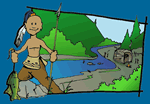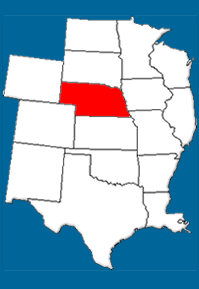


Geography and Landforms:
Nebraska is bordered by South Dakota on the north and by Colorado and Kansas on the south. On the east, Nebraska is bordered by Iowa and Missouri, and on the west, by Colorado and Wyoming.
|
 History:
In 1541, Spanish explorer Francisco Vasquez de Coronado led an expedition across the US Southwest and claimed the entire territory for Spain, although no Spanish settlements were ever established in Nebraska. In 1682, French explorer Rene Robert Cavalier, Sieur de La Salle traveled the Mississippi River, and claimed all the land drained by the Mississippi and its tributaries for France. This area, which he named "Louisiana" in honor of King Louis XIV, included what is now Nebraska. In 1714, French explorer Etienne Veniard de Bourgmont traveled the Mississippi River and explored the mouth of the Platte River in Nebraska. At this point, both Spain and France had "claimed" the region of Nebraska, and in 1720, a group of 45 Spanish soldiers, led by Pedro de Villasur, marched into Nebraska hoping to drive out the French. However, the Pawnee Indians attacked and killed most of the expedition in a battle near the Platte River. In 1739, two more French explorers, Pierre and Paul Mallet, traveled from Illinois to Santa Fe, New Mexico, named the Platte River and explored nearly the entire length of what is now Nebraska, solidifying the French claim to the area.
|
 Economy:
Nebraska's economy is dominated by agriculture. The chief farm products are cattle, corn, hogs, soybeans, and wheat. Nebraska is second in the US in its cattle production. The largest industry in the state, food processing, is also related to its agricultural roots. More varieties of grass grow in Nebraska than in any other state, and this resource is valuable for livestock forage. The cities of Dakota City and Lexington are among the largest meat-packing centers in the U.S.
|
 First Inhabitants:
The earliest inhabitants of the land we now call Nebraska were nomadic hunters who lived on the land between 10,000 and 25,000 years ago. Archaeologists have found stone tools and weapons that these people used. Throughout history, the climate in Nebraska varied between long periods of drought and times of plentiful moisture. We know that at one time, the area was covered by an inland sea and had a tropical climate. Later, glaciers covered the land. This constant change meant that people came and went from the area. This created a diverse mixture of Indian languages and cultures.
|
Books Related To NebraskaAnna's Blizzard - Alison Hart C is for Cornhusker: A Nebraska Alphabet - Rajean Luebs Shepherd Dandelions - Eve Bunting Elsie's Bird - Jane Yolan Holding up the Earth - Dianne Gray The Huckabuck Family and How They Raised Popcorn in Nebraska and Quit and Came Back - Carl Sandburg Room One: A Mystery or Two - Andrew Clements Worth - A. LaFaye |
Famous Citizens:
|
| Capital: | Lincoln |
| Entered Union: | March 1, 1867 |
| Population: | 1,881,503 |
| Area | 77,354 |
| Bird | Western Meadowlark |
| Flower | Goldenrod |
| Nickname: | Cornhusker State |
| Governor | Pete Ricketts |
Places to Visit in Nebraska: (Click the links to learn more.)
|



